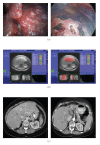Cyberknife stereotactic body radiation therapy for nonresectable tumors of the liver: preliminary results
- PMID: 20689733
- PMCID: PMC2905697
- DOI: 10.1155/2010/309780
Cyberknife stereotactic body radiation therapy for nonresectable tumors of the liver: preliminary results
Abstract
Purpose: Stereotactic body radiation therapy (SBRT) has emerged as a treatment option for local tumor control of primary and secondary malignancies of the liver. We report on our updated experience with SBRT in patients with non-resectable tumors of the liver.
Methods: Our first 17 consecutive patients (mean age 58.1 years) receiving SBRT for HCC (n = 6), IHC (n = 3), and LM (n = 8) are presented. Mean radiation dose was 34 Gy delivered over 1-3 fractions.
Results: Treated patients had a mean decrease in maximum pretreatment tumor diameter from 6.9 +/- 4.6 cm to 5.0 +/- 2.1 cm at three months after treatment (P < .05). The mean total tumor volume reduction was 44% at six months (P < .05). 82% of all patients (14/17) achieved local control with a median follow-up of 8 months. 100% of patients with HCC (n = 6) achieved local control. Patients with surgically placed fiducial markers had no complications related to marker placement.
Conclusion: Our preliminary results showed that SBRT is a safe and effective local treatment modality in selected patients with liver malignancies with minimal adverse events. Further studies are needed to define its role in the management of these malignancies.
Figures



Similar articles
-
Stereotactic body radiation therapy for nonresectable tumors of the pancreas.J Surg Res. 2012 May 15;174(2):319-25. doi: 10.1016/j.jss.2011.07.044. Epub 2011 Sep 5. J Surg Res. 2012. PMID: 21937061 Free PMC article.
-
Stereotactic body radiation therapy for benign spine tumors: is dose de-escalation appropriate?J Neurosurg Spine. 2018 Aug;29(2):220-225. doi: 10.3171/2017.12.SPINE17920. Epub 2018 May 25. J Neurosurg Spine. 2018. PMID: 29799334 Free PMC article.
-
Stereotactic Body Radiotherapy (SBRT) for Spinal Metastases: Who Will Benefit the Most from SBRT?Technol Cancer Res Treat. 2015 Apr;14(2):159-67. doi: 10.7785/tcrt.2012.500411. Epub 2014 Nov 21. Technol Cancer Res Treat. 2015. PMID: 24502552
-
Stereotactic body radiation therapy with or without transarterial chemoembolization for patients with primary hepatocellular carcinoma: preliminary analysis.BMC Cancer. 2008 Nov 27;8:351. doi: 10.1186/1471-2407-8-351. BMC Cancer. 2008. PMID: 19038025 Free PMC article.
-
Stereotactic body radiation therapy of liver tumors: post-treatment appearances and evaluation of treatment response: a pictorial review.Abdom Radiol (NY). 2016 Oct;41(10):2061-77. doi: 10.1007/s00261-016-0768-x. Abdom Radiol (NY). 2016. PMID: 27167232 Review.
Cited by
-
Comprehensive Treatment Uncertainty Analysis and PTV Margin Estimation for Fiducial Tracking in Robotic Liver Stereotactic Body Radiation Therapy.Curr Med Sci. 2023 Jun;43(3):572-578. doi: 10.1007/s11596-023-2717-6. Epub 2023 May 5. Curr Med Sci. 2023. PMID: 37142817
-
Current management of patients with hepatocellular carcinoma.World J Hepatol. 2015 Jul 28;7(15):1913-20. doi: 10.4254/wjh.v7.i15.1913. World J Hepatol. 2015. PMID: 26244066 Free PMC article.
-
Local effect of stereotactic body radiotherapy for primary and metastatic liver tumors in 130 Japanese patients.Radiat Oncol. 2014 May 10;9:112. doi: 10.1186/1748-717X-9-112. Radiat Oncol. 2014. PMID: 24886477 Free PMC article.
-
The Evolving Role of Radiation Therapy in the Treatment of Biliary Tract Cancer.Front Oncol. 2020 Dec 14;10:604387. doi: 10.3389/fonc.2020.604387. eCollection 2020. Front Oncol. 2020. PMID: 33381458 Free PMC article. Review.
-
A study of the interplay effect for VMAT SBRT using a four-axes motion phantom.J Appl Clin Med Phys. 2020 Aug;21(8):208-215. doi: 10.1002/acm2.12947. Epub 2020 Jun 23. J Appl Clin Med Phys. 2020. PMID: 32573908 Free PMC article.
References
-
- El-Serag HB, Rudolph KL. Hepatocellular carcinoma: epidemiology and molecular carcinogenesis. Gastroenterology. 2007;132(7):2557–2576. - PubMed
-
- Fuss M, Thomas CR., Jr. Stereotactic body radiation therapy: an ablative treatment option for primary and secondary liver tumors. Annals of Surgical Oncology. 2004;11(2):130–138. - PubMed
-
- Llovet JM. Updated treatment approach to hepatocellular carcinoma. Journal of Gastroenterology. 2005;40(3):225–235. - PubMed
-
- Llovet JM, Ricci S, Mazzaferro V, et al. Sorafenib in advanced hepatocellular carcinoma. New England Journal of Medicine. 2008;359(4):378–390. - PubMed
-
- Young RF. The role of the gamma knife in the treatment of malignant primary and metastatic brain tumors. Ca: A Cancer Journal for Clinicians. 1998;48(3):177–188. - PubMed
MeSH terms
LinkOut - more resources
Full Text Sources
Medical

